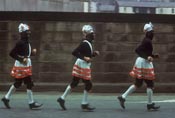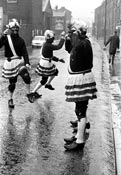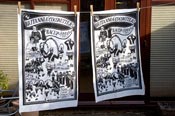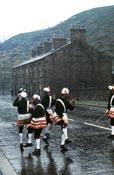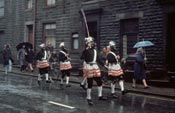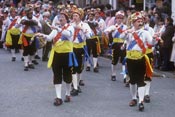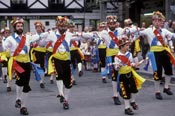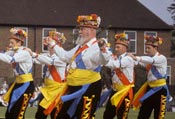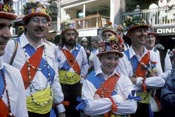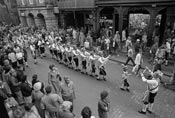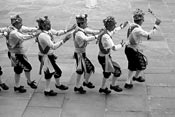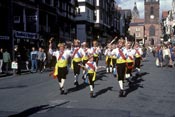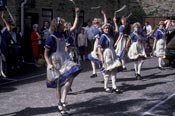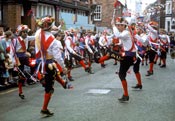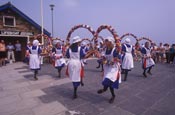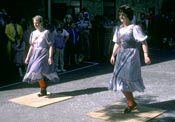
North West Morris is native to Lancashire, Cheshire and the Pennines in West Yorkshire but so popular that the style has spread all over England. It probably developed from ‘Cotswold Morris’ in the nineteenth century during the Industrial Revolution but it is more robust, military and macho, like the men (and women) from the mills and factories. It is also done in clogs, often to a substantial band which includes a drum. No prancing about waving handkerchiefs for them, by ‘eck. And quite right too for the style is absolutely right for the uncompromising surroundings. Curiously, since Andy Cappism is by no means dead in these parts to this day, women took part in ‘Clog’ morris dancing right from the earliest days, both in female and mixed sides, very unusual from a ‘custom’ point of view. On the other hand individual clog or step dancing was already well established among mill workers both for fun and in competitions so perhaps it is understandable. We have a couple of women’s teams here. Our men’s teams seem almost exclusively about Manley Morris Dancers – now alas no more - but that is because we knew them quite well! North West Morris sides have a minimum of eight dancers, sometimes with a ninth ‘point dancer’, plus a captain who calls the figures and keeps them in order. Leslie Haworth at Manley was a notable example. It is essentially a processional dance, ideal to accompany rushcarts and the May Queen, as at Knutsford.
The Britannia Coconut Dancers from Bacup are firmly in the North West Morris tradition, but with considerable added value. Every Easter Saturday, to the Stacksteads Silver Band, the ‘Nutters’ dance from their headquarters in Britannia a mile or so into the centre of Bacup then another mile out to Stacksteads stopping to perform set dances and take on fuel many, many times on the way. Their five ‘garland’ dances are fairly standard North West Morris but their two ‘Nut Dances’ and their processional dance are unique to Bacup. Their bizarre costume includes five ‘nuts’ (maple wood discs), one on each knee, one in each palm, and a single one at the waist, which they knock together in a complex rhythm as they dance. It is truly fantastic. In their processional dance they divide into two groups of four who proceed alternately along either side of the road 1-2-3-skip, 1-2-3-skip then a pause for a little nut dance, while the band plods along in the middle of the road and the ‘Wiffler’ with his whip clears away the traffic. The official line is that he is driving off evil spirits. Their black faces are of course traditional folk disguise, unusual in NW Morris but derigueur in Border Morris. Fanciful stories of the origins of the Britannia Coconut Dancers abound but it is fairly certain they were assembled around 1857 from the remnants of two or three other teams that had been active in the area up to that date. Whatever, they provide one of the great days in the folk calendar.
